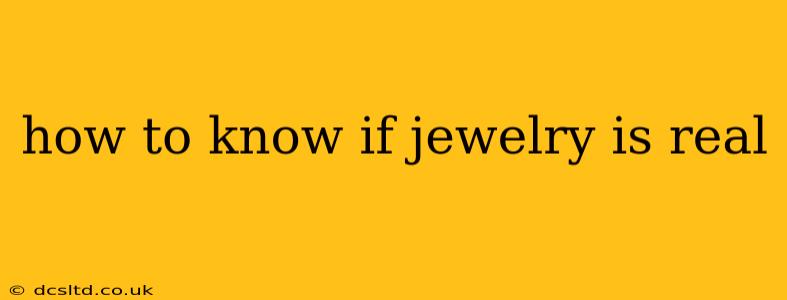Determining the authenticity of jewelry can be tricky, especially with the proliferation of high-quality counterfeits. This comprehensive guide will equip you with the knowledge and techniques to distinguish real gold, silver, platinum, and gemstones from their imitations. Whether you're a seasoned collector or a first-time buyer, understanding these methods will help you make informed decisions and protect your investment.
What are the Different Tests to Determine if Jewelry is Real?
Several methods can help you assess the authenticity of jewelry. These range from simple at-home tests to professional appraisals. The best approach depends on the type of metal and gemstone in question.
1. The Magnet Test:
This is a quick and easy way to screen for the presence of certain metals. Gold, silver, and platinum are not magnetic, while many cheaper alternatives (like iron or nickel alloys) are. If your jewelry is strongly attracted to a magnet, it's highly unlikely to be made of precious metals. However, this test isn't foolproof, as some gold alloys might show a slight attraction, and non-magnetic metals can be used in conjunction with magnetic ones.
2. The Acid Test:
This is a more advanced method requiring a jeweler's acid test kit. These kits contain various acids that react differently with different metals. A small, inconspicuous part of the jewelry is rubbed against a testing stone, and a drop of acid is applied. The color change of the acid indicates the metal's composition. This test should only be performed by professionals or with proper training and safety precautions, as acids are corrosive.
3. The Hallmark/Stamp Test:
Authentic precious metal jewelry usually bears a hallmark or stamp indicating its purity (e.g., 14K, 18K for gold; 925 for sterling silver). Examine the piece carefully for markings, usually located on a less visible area. These marks are a strong indicator of authenticity, but counterfeits can sometimes mimic them. Knowing the standard hallmarks for different countries can help verify their authenticity.
4. The Density Test:
This involves measuring the jewelry's weight and volume to calculate its density. Each precious metal has a specific density, allowing for comparison. This is a precise method, but it usually requires specialized tools and expertise.
5. The Visual Inspection:
A keen eye can pick up subtle clues. Examine the piece for imperfections, inconsistencies in color or texture, and poorly finished details. Real gemstones usually exhibit superior clarity, brilliance, and overall craftsmanship.
How Can I Tell if Gold Jewelry is Real?
Determining the authenticity of gold jewelry requires a combination of the above methods. Look for hallmarks such as "10K," "14K," "18K," or "24K," indicating the karat (purity) of the gold. Remember that higher karats mean higher gold content. The magnet test and acid test can also be useful, but professional appraisal is advisable for valuable pieces.
How Can I Tell if Silver Jewelry is Real?
Sterling silver is usually marked with "925," indicating 92.5% silver content. Look for this hallmark. The magnet test might be slightly inconclusive, as some alloys may exhibit weak magnetism. Visual inspection for quality and craftsmanship also plays a crucial role.
How Can I Tell if My Gemstones Are Real?
Gemstone identification is a complex field requiring expertise. While some at-home tests exist, accurate identification often needs professional gemological instruments and trained eyes. Look for inclusions (internal flaws) in the stone, as these are common in natural gems, but skillfully imitated gems can sometimes lack them. A gemologist can use magnification, light sources, and specialized tools to determine the stone's nature and authenticity.
What Should I Do if I Suspect My Jewelry is Fake?
If you suspect your jewelry is fake, seek a professional appraisal from a reputable jeweler or gemologist. They possess the expertise and equipment needed for accurate assessment. Don't attempt destructive tests yourself, especially on valuable pieces.
How Can I Avoid Buying Fake Jewelry?
- Buy from reputable sources: Choose established jewelers with a proven track record and good customer reviews.
- Ask for certificates of authenticity: Reputable sellers often provide certificates guaranteeing the authenticity of their jewelry.
- Check for hallmarks and stamps: Pay close attention to the markings on the jewelry.
- Compare prices: Be wary of deals that seem too good to be true.
- Research the seller: Read reviews and check the seller's reputation before making a purchase.
By combining these methods and exercising caution, you can increase your chances of buying and owning authentic jewelry. Remember, investing in a professional appraisal for valuable pieces offers the most accurate and reliable way to determine their authenticity.
